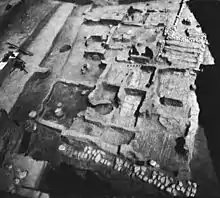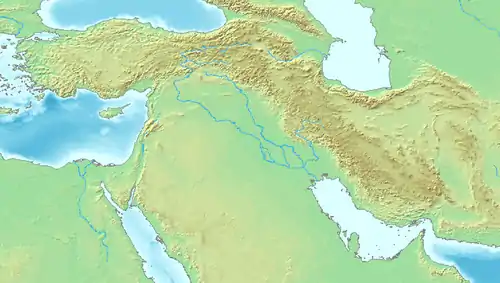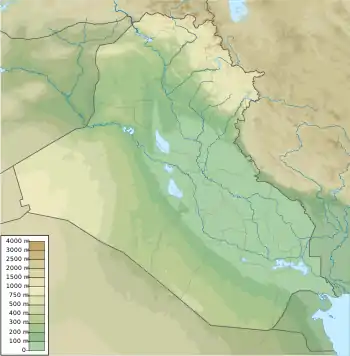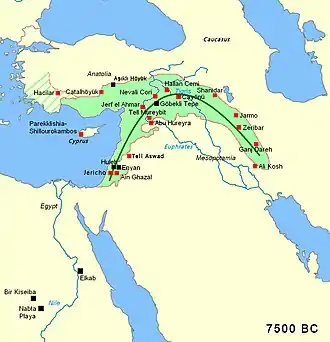Jarmo
Jarmo (Qal'at Jarmo) (Kurdish: Çermo) is a prehistoric archeological site located in modern Iraq on the foothills of the Zagros Mountains. It lies at an altitude of 800 m above sea-level in a belt of oak and pistachio woodlands. Excavations revealed that Jarmo was an agricultural community dating back to 7090 BC. It was broadly contemporary with such other important Neolithic sites such as Jericho in the southern Levant and Çatal Hüyük in Anatolia.
Çermo | |
 The Neolithic village of Jarmo in Iraq, 1954 | |
 Shown within Near East  Jarmo (Iraq) | |
| Alternative name | Charmo |
|---|---|
| Location | Chamchamal, Iraqi Kurdistan |
| Region | Mesopotamia |
| Coordinates | 35°32′56″N 44°57′1″E |
| Type | Settlement |
| Area | 12,000 to 16,000 m2 (170,000 sq ft) |
| History | |
| Founded | Approximately 7500 BC |
| Abandoned | Approximately 5000 BC |
| Periods | Neolithic |
| Management | Kurdistan Regional Government |
Discovery and excavation
The site was originally discovered by the Iraqi Directorate of Antiquities in 1940, and later became known to archaeologist Robert Braidwood from the University of Chicago Oriental Institute. At the time, he was looking for suitable places to research the origins of the Neolithic Revolution.[1][2] Braidwood worked as part of the Iraq-Jarmo programme for three seasons, those of 1948, 1950–51 and 1954–55; a fourth campaign, to be carried out in 1958–59 did not come about because of the 14 July Revolution. During the excavations in Jarmo in 1954–55, Braidwood used a multidisciplinary approach for the first time, in an attempt to refine the research methods and clarify the origin of the domestication of plants and animals. Among his team were a geologist, Herbert Wright, a palaeo-botanist, Hans Helbaek, an expert in pottery and radio-carbon dating, Frederic Mason, and a zoologist, Charles Reed, as well as a number of archaeologists. The interdisciplinary method was subsequently used in all serious field work in archaeology.
Jarmo, the village


The excavations exposed a small village, covering an area of 12,000 to 16,000 m², and which has been dated (by carbon-14) to 7090 BC, for the oldest levels, to 4950 BC for the most recent. The entire site consists of twelve levels. Jarmo appears to be two older, permanent Neolithic settlements and, approximately, contemporary with Jericho or the Neolithic stage of Shanidar. The high point is likely to have been between 6,200 and 5,800 BC. This small village consisted of some twenty five houses, with adobe walls and sun-dried mud roofs, which rested on stone foundations, with a simple floor plan dug from the earth. These dwellings were frequently repaired or rebuilt. In all, about 150 people lived in the village, which was clearly a permanent settlement. In the earlier phases there is a preponderance of objects made from stone, silex—using older styles—and obsidian. The use of this latter material, obtained from the area of Lake Van, 200 miles away, suggests that some form of organized trade already existed, as does the presence of ornamental shells from the Persian Gulf. In the oldest level baskets have been found, waterproofed with pitch, which is readily available in the area.
Agriculture and cattle farming

Agricultural activity is attested by the presence of stone sickles, cutters, bowls and other objects, for harvesting, preparing and storing food, and also by receptacles of engraved marble. In the later phases instruments made of bone, particularly perforating tools, buttons and spoons, have been found. Further research has shown that the villagers of Jarmo grew wheat of two types, emmer and einkorn, a type of primitive barley and lentils (it is common to record the domestication of grains, less so of pulses). Their diet, and that of their animals, also included species of wild plant, peas, acorns, carob seeds, pistachios and wild wheat. Snail shells are also abundant. There is evidence that they had domesticated goats, sheep and dogs. On the higher levels of the site pigs have been found, together with the first evidence of pottery.
Pottery and religion
Jarmo is one of the oldest sites at which pottery has been found, appearing in the most recent levels of excavation, which dates it to the 7th millennium BC. This pottery is handmade, of simple design and with thick sides, and treated with a vegetable solvent. There are clay figures, zoomorphic or anthropomorphic, including figures of pregnant women which are taken to be fertility goddesses, similar to the Mother Goddess of later Neolithic cultures in the same region. These constitute the inception of the Art of Mesopotamia.
Relative chronology
Notes
| Wikimedia Commons has media related to Jarmo. |
- L. S. Braidwood et al., Prehistoric Archeology Along the Zagros Flanks, Oriental Institute Publications 105, 1983, ISBN 0-918986-36-2
- Robert J. Braidwood, The Iraq-Jarmo Project of the Oriental Institute of the University of Chicago, Season 1954–1955, Verlag nicht ermittelbar, 1954
- Liverani, Mario (2013). The Ancient Near East: History, Society and Economy. Routledge. p. 13, Table 1.1 "Chronology of the Ancient Near East". ISBN 9781134750917.
- Shukurov, Anvar; Sarson, Graeme R.; Gangal, Kavita (7 May 2014). "The Near-Eastern Roots of the Neolithic in South Asia". PLOS ONE. 9 (5): e95714. Bibcode:2014PLoSO...995714G. doi:10.1371/journal.pone.0095714. ISSN 1932-6203. PMC 4012948. PMID 24806472.
- Bar-Yosef, Ofer; Arpin, Trina; Pan, Yan; Cohen, David; Goldberg, Paul; Zhang, Chi; Wu, Xiaohong (29 June 2012). "Early Pottery at 20,000 Years Ago in Xianrendong Cave, China". Science. 336 (6089): 1696–1700. Bibcode:2012Sci...336.1696W. doi:10.1126/science.1218643. ISSN 0036-8075. PMID 22745428.
- Thorpe, I. J. (2003). The Origins of Agriculture in Europe. Routledge. p. 14. ISBN 9781134620104.
- Price, T. Douglas (2000). Europe's First Farmers. Cambridge University Press. p. 3. ISBN 9780521665728.
- Jr, William H. Stiebing; Helft, Susan N. (2017). Ancient Near Eastern History and Culture. Routledge. p. 25. ISBN 9781134880836.
References
- R.J. Braidwood, "Jarmo: A village of early farmers in Iraq", Antiquity, vol. 24, pp. 189–195, 1950,
- J. M. Adovasio, "The Textile and Basketry Impressions from Jarmo", Paléorient, vol. 3, iss. 3, pp. 223–230, 1975